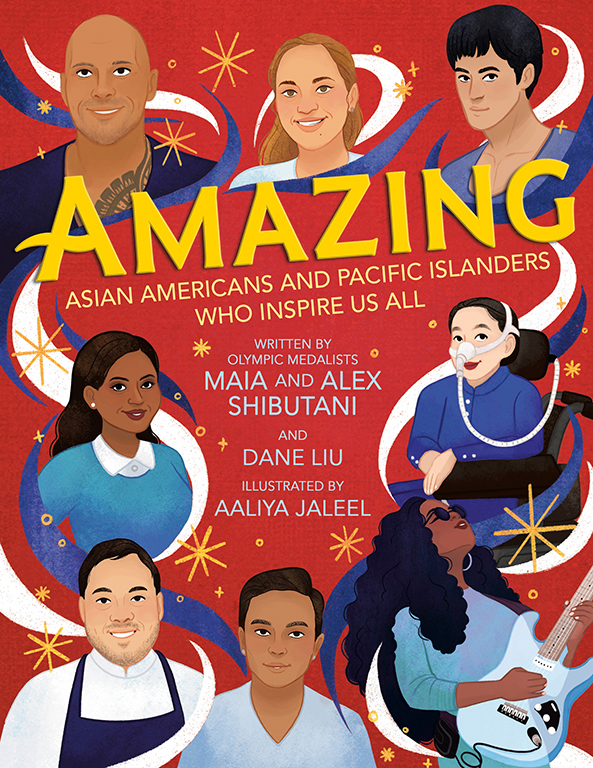By Samantha Pak
NORTHWEST ASIAN WEEKLY
The Asian American and Pacific Islander (AAPI) diaspora is a vast community, whose members have made contributions to the world throughout history, and continue to do so.
Some of these accomplishments are highlighted in Alex Shibutani and Maia Shibutani’s new picture book, “Amazing: Asian Americans and Pacific Islanders Who Inspire Us All.” Written with Dane Liu and illustrated by Aaliya Jaleel, the book was released today (April 18) and features 36 historical and contemporary AAPI figures.
Alex, 31, and Maia, 28—the brother-sister ice dancing team with two Olympic bronze medals, three world medals, and two national titles under their belts—first made a name for themselves on the figure skating circuit. They even made history themselves at the 2018 Winter Olympics when they became the first ice dancers of Asian descent to medal in their event. Also known as the ShibSibs, they’re only the second sibling duo in their sport’s history to win an ice dancing medal at the Olympics.
Over the last few years the pair, who started skating together when they were 12 and 9, have shifted careers and taken their penchant for storytelling from the ice to the page. “Amazing” is their third book together. Their previous two projects—the first and second installments of their Kudo Kids series (released in 2020 and 2021)—are middle-grade books that follow Andy and Mika, a mystery-solving Japanese American brother and sister duo.
Getting the ball rolling
“Amazing” is the culmination of more than two years of work. Maia said they created the non-fiction children’s book because there had been nothing like it before—a book that uplifts AAPIs and educates readers about key figures in the community. To ensure the book is accessible to young readers, the co-authors include only a short biography about each person highlighted, but made sure they were complete so readers could still learn. Their goal is to pique readers’ interests enough to dig deeper about these individuals on their own.
“We hope to get the ball rolling,” Alex said, pointing out that AAPI history is not required in K-12 education in most states, though that is slowly changing. “This is just hopefully the start.”
He added that they also wanted to highlight certain eras in history and serve as an introduction for readers and encourage them to learn more about these times themselves.
For example, they included the late photojournalist Young Kwok “Corky” Lee, who made a career of documenting the AAPI community. In 2014, Lee famously recreated a photo celebrating the completion of the transcontinental railroad with the descendants of the Chinese workers, who were largely responsible for building the railroad, but excluded from the historical photo because of anti-Asian racism at the time.
‘Certainly not everyone’
When it came to picking who would be featured in the book, Alex and Maia included people from different eras of history, ethnic backgrounds, and career fields. From Wong Kim Ark, the man responsible for birthright citizenship in the United States, and activists Helen Zia and Alice Wong, to fashion designer Prabal Gurung, and veterans and politicians Daniel Inouye and Tammy Duckworth, the individuals cover a broad range of experiences.
But narrowing down the number to three dozen was a challenge.
“Thirty-six is certainly not everyone,” Maia acknowledged.
As they researched for “Amazing,” Alex and Maia said they learned a lot. And as members of Team USA, they admitted their surprise at learning about some of the athlete trailblazers, since this is their area of expertise. Because while someone like Suni Lee, the first Hmong American Olympian and first gymnast of Asian descent to win the all-around gold medal, made headlines in recent years, the stories of history makers like divers Victoria Manalo Draves and Dr. Sammy Lee—the first and second Asian Americans to win Olympic gold at the 1948 Summer Olympics—haven’t been as widely told and aren’t as large of a part of the culture.
While including historical figures is to encourage readers to learn more on their own, the inclusion of contemporary figures is to give readers people they can continue to follow in their careers.
“With our living legends in this community, how can we support them and cheer them on?” Maia said.
A real-time response to the real world
Part of the reason the Shibutanis wrote “Amazing” was a result of the rise of anti-AAPI racism and violence during the pandemic. Like most people, they were at home seeing the attack after attack on the news, with growing concerns about the racism and rhetoric toward and about the AAPI community.
There was also the murder of George Floyd at the hands of law enforcement officers. As the country went through a racial reckoning, Alex said this also caused him and his sister to reflect on their own personal experiences and how many things they went through as ice skaters were informed by their race, even though they told themselves at the time that they weren’t. This is why they made sure to include the hardships people experienced along the way in “Amazing.”
“They are not alone in the struggle,” Alex said.
The pair also thought about what it would be like for kids once they returned to in-person learning. They wanted to inspire readers (AAPI and non-AAPI) and hope the book builds empathy for the community through education. Alex acknowledged that while the AAPI has made a lot of progress, there is still more to do. But it’s also important to give ourselves these moments of celebration and acknowledgement as we continue the journey, he said.






